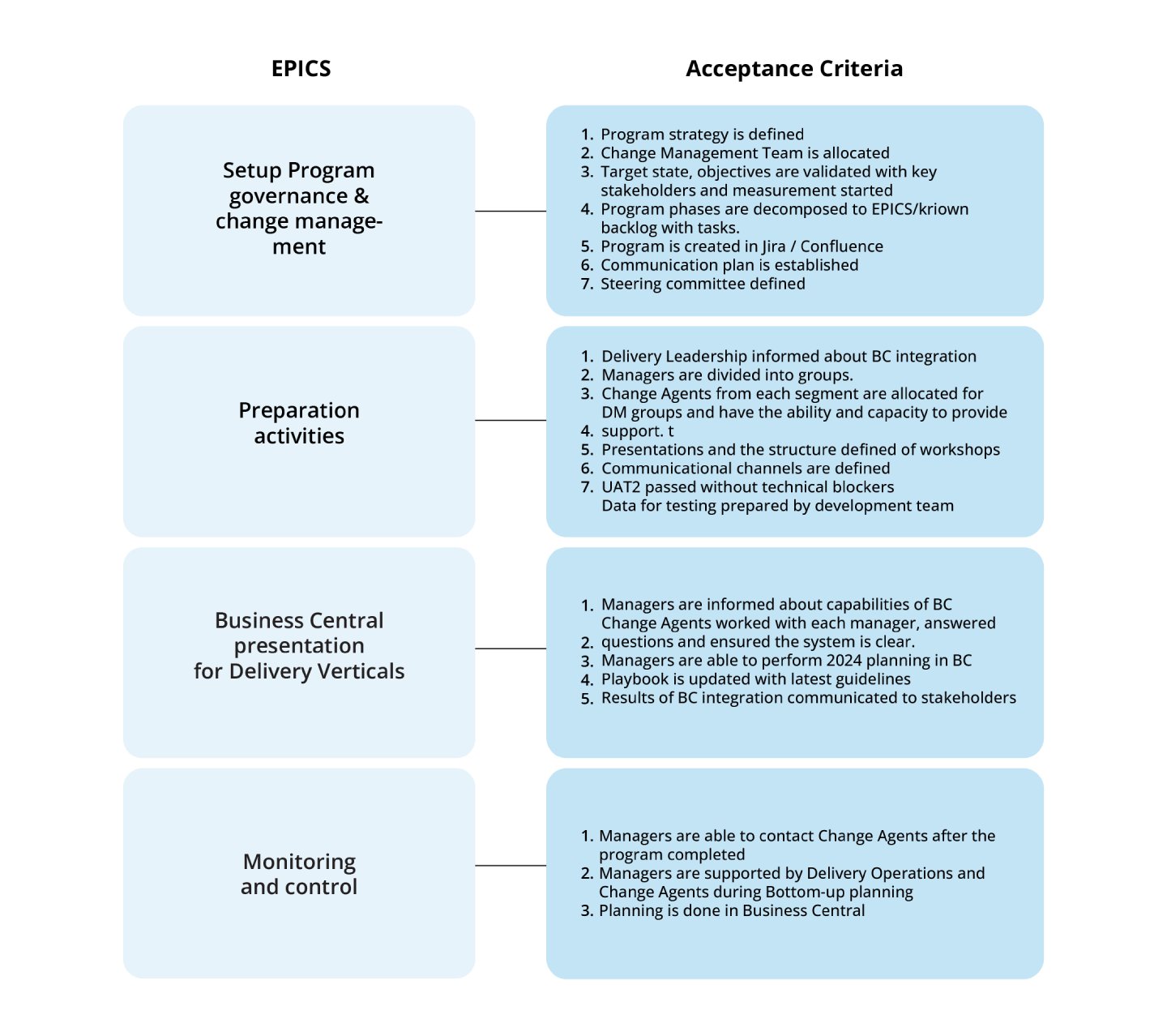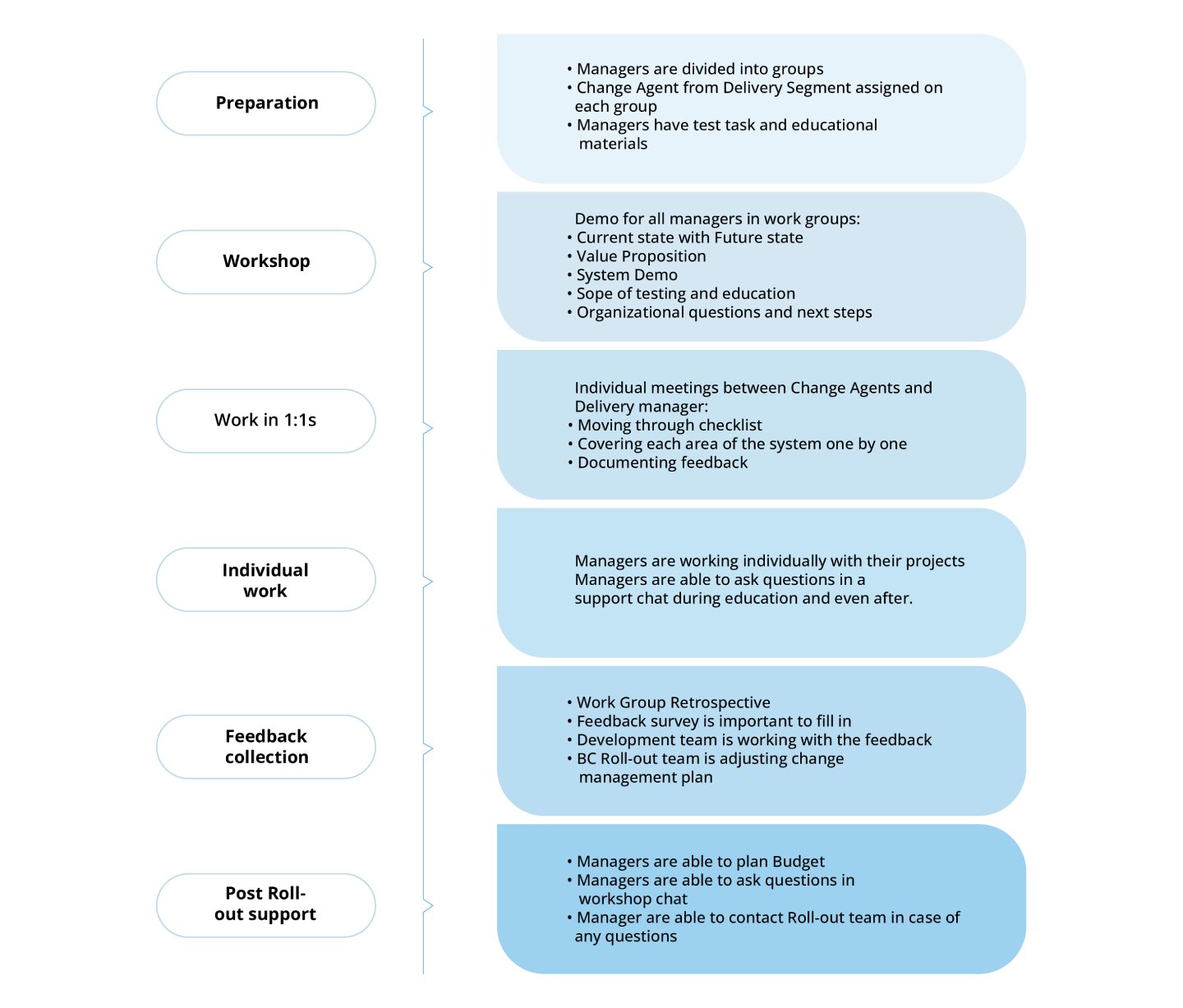Conquering new heights—isn’t that the goal of any business? Yet, aspiring for more draws the need for constant change, for staying agile, for digital transformation and change management. Implementing new technologies is crucial, but evolving processes, strategy, and most importantly, people—is vital.
Most business leaders are really invested in finding new tools, automating processes, implementing new technologies, but they often overlook the human side of change. People tend to resist changes, delay them, or even fail to accept. That’s where the importance of change management in digital transformation lies. Your employees have to not only understand why changes are happening but also feel ready and motivated to embrace them.
And since the ability to adapt to change is becoming a critical element of business survival, knowing how to lead your employees through the transformation without guesswork and disruption can put you head and shoulders above competitors.
What are change management strategies in digital transformation?
When making fundamental shifts in processes, either internal or external, organizations need defined frameworks and sets of protocols. Change management strategies exist precisely for that, to bridge the gap between digital transformation initiatives and people. For example, implementing a new customer relationship management (CRM) tool isn’t just about faster data entry; it’s about enhancing customer satisfaction and driving growth.
The primary purpose of change management strategy is to give organizational leaders and their employees tangible guidelines to reduce errors, increase workflow efficiency, or improve customer response times. Apart from that, change management is aimed at aligning broader business strategies and ensuring each initiative is a part of a cohesive plan, not a disconnected experiment.
Current issues of change management in digital transformation
Many organizations face recurring challenges when attempting digital transformation:
- Stressing about technology: Leaders often focus more on tools than the people using them. Without proper training and communication, employees may resist new processes or revert to familiar methods.
- Vaguely defined goals: When changes lack clear objectives, progress becomes difficult to measure. Employees can’t understand the benefits, leading to frustration and disengagement.
- Guess-road to change: Securing buy-in from decision-makers and frontline staff can be difficult. If people don’t see the value in a new system, even the best tools can fail to deliver results.
These challenges highlight why change management is not a supplementary process but a foundational one.
Why change management is critical for transformation success
Change management ensures that digital transformation is not merely a technical upgrade but a full-fledged framework for organizations to:
- Align initiatives with strategic goals: Every change has to support an organization’s broader objectives.
- Drive employee engagement: People need to understand and embrace new tools and processes.
- Ensure long-term success: Changes need to be perceived as opportunities, not a disruption.
As highlighted in Forbes, organizations that integrate change management into digital transformation are more likely to achieve sustainable success. For transformative growth happens only through prioritizing communication, clear goal-setting and continuous support of employees.
How is change management different in digital transformation?
Traditionally, any organizational change focuses on isolated updates, such as single process improvement or tools optimization. Digital transformation, by contrast, impacts the entire organization—from team structures to customer interactions. On this scale, any change would require a comprehensive, encompassing approach, addressing not only technical but cultural shifts, too.
Let’s take the modern financial system implementation for example. Change like that would require the redefinition of job roles, the adjustment of workflow, and the (re)training of the team. Therefore, change management must address the full spectrum of development, covering everything, from technical upgrades to human behaviors. Simply teaching the employees how to use a tool is not enough. It’s more about guiding them through a holistic transformation of how work is done.
Key realities transformation leaders must embrace
To achieve success in digital transformation, leaders must adopt key realities that reflect the dynamic and ongoing nature of change. Traditional change management and digital transformation approaches often fall short in the face of business modification complexities. These realities highlight the mindset and strategies needed for sustainable success:
1. There’s no tunnel, there’s no light
Transformation is not a linear journey with a clear endpoint. It is a continuous cycle of adaptation and growth. So, the ultimate goal here is to create an organization that is adaptive, innovative, resilient, and—thrives on change instead of trying to move from one stable state to another. With the focus on fostering a culture where change is a constant, a welcomed and expected part of operations, the organization embraces the reality of having no “finish line” in changes, only ongoing evolution.
2. Not everybody wins
The hard truth is—not every employee or role will benefit from transformation, and strong leadership is all about knowing and acknowledging it. Skills that were once essential may become obsolete, team structures may need to be redefined, the possibilities of workforce reductions can appear along the route. Each of these issues requires honest clear communication, reporting both benefits and challenges of change. Prepare your employees for these shifts with transparency—and you will notice a significant difference in building trust and engagement.
3. If incentives don’t change, behaviors won’t either
Organizations have ingrained ways of operating—”muscle memory” built over time. Changing these patterns requires more than verbal encouragement; it demands tangible adjustments to incentives and performance metrics. Employees are more likely to embrace new behaviors when they see those behaviors rewarded. Aligning rewards with transformation goals not only encourages participation but also embeds the desired changes into the organizational culture. Leaders must ensure that incentives reinforce the new norms rather than perpetuate outdated practices.
4. You can indeed overcommunicate
The phrase “you cannot overcommunicate” has often been misinterpreted, leading to an overload of repetitive, one-directional messaging. True communication is a two-way process. Leaders must prioritize listening to employees’ concerns and addressing them directly. Targeted communication strategies, tailored to the specific needs and apprehensions of different teams, are far more effective than broad, generalized messages. This approach not only builds trust but also demonstrates a commitment to understanding and resolving the issues that matter most to employees.
5. C-suite backing is not enough
While senior executive support is essential, it’s not sufficient to drive transformation success. Middle management plays a critical role in bridging the gap between strategy and execution. These leaders are often the closest to the teams implementing changes, making their buy-in and participation vital. Transformation leaders must actively engage middle managers, providing them with the tools, training, and information needed to lead their teams effectively through the transformation. Empowering this layer of leadership ensures that the vision is translated into actionable steps across the organization.
By embracing these realities, transformation leaders can navigate the complexities of digital transformation with a mindset and approach that fosters adaptability, transparency, and engagement at all levels of the organization.
Change management strategies for digital transformation
Consider these key approaches to tailor an effective change management strategy:
- Start from the top: Leadership must champion change and demonstrate commitment through actions, not just words.
- Make sure the change is necessary and desirable: Clearly communicate the “why” behind the transformation, showing employees how it benefits them and the organization.
- Minimize disruption: Plan carefully to ensure changes don’t interrupt day-to-day operations.
- Promote communication: Use workshops, updates, and one-on-one sessions to keep everyone informed and engaged.
- Recognize that change is the norm, not the exception: Foster a culture where adaptability is valued and celebrated.
Case study: Transforming financial systems with change management
Change is never easy. A change of the entire financial system sounds like a mission impossible. Yet when we at Intellias recognized the need for modernization to support our global expansion, we decided to replace our outdated financial system by implementing Microsoft Business Central (BC).
However, this shift was more than a technical upgrade—we knew it required a hands-on change management mindset.
We began by asking ourselves, what is a failure in digital transformation projects? Thus, coming up with a list of things not to do:
- Fail to use a structured change management framework.
- Neglect project and program management best practices.
- Overlook the well-being and engagement of employees.
To avoid common mistakes of business digital transformation, we adopted Kotter’s 8-Step Model—a gold standard for managing large-scale modifications:
Step 1: Create “the why”
The limited capacity of our legacy financial system has been an issue for quite some time, and, as communicated by our leaders, inaction was a much bigger risk than change across all levels of the organization. So, we conducted thorough research —to know for sure — adopting Microsoft Business Central was the solution. That is how the stage for shared commitment to the transformation was set.
Step 2: Build the guiding team
We assembled a cross-functional team of experts from Finance, IT, and PMO to lead the initiative. Their goal was to engage all the stakeholders, support the development team, and use their expertise and dedication to ensure alignment of all processes throughout the major change. Choosing the right people for this job is 90% success.
Step 3: Develop vision and strategy
We crafted a clear vision and actionable strategy for the transformation. This included breaking down the change into manageable “Epics,” each with specific acceptance criteria. For example:
- Establishing program governance and change management structures.
- Defining measurable objectives validated by key stakeholders.
- Preparing a detailed communication plan to keep everyone informed.

Step 4: Communicate the vision
Transparent communication was central to our approach. We utilized workshops, regular updates, and individual meetings to ensure all employees understood the transformation’s goals and benefits. Change Agents—influential representatives from each department—worked closely with teams to address concerns and provide guidance.

Step 5: Empower broad-based action
To remove barriers, we streamlined workflows and addressed technical challenges. Leaders provided teams with the resources and support needed to take initiative. This empowered employees to actively participate in the transformation, reducing delays and fostering a culture of collaboration.
Step 6: Generate short-term wins
Early wins were critical to maintaining momentum. For instance, managers completed educational sessions and shared positive feedback on how the system simplified their tasks. These successes were celebrated, reinforcing the value of transformation and boosting morale.
Step 7: Sustain acceleration
Building on early successes, we expanded the scope of the transformation. Training sessions were extended to additional teams, ensuring widespread adoption. Leaders remained actively involved, applying lessons learned to refine strategies and accelerate progress toward our ultimate goals.
Step 8: Institute change
To embed the transformation, we developed comprehensive training programs and updated policies to align with the new system. Success metrics were established to monitor performance, ensuring the financial system became a cornerstone of our operations. Feedback loops kept the system evolving to meet organizational needs.
We have treated the shift to a new financial system as a standalone project, giving ourselves time and opportunity to implement a sustainable change management framework. Constant care about stakeholders’ feedback minimized change resistance and stress because people really saw that the company cares about their work comfort and doing everything possible to provide support. This change was not only about digital transformation. It was about the high level of corporate culture.
Bottom line
The role of change management in digital transformation is hard to overestimate. It aligns people, processes, and technology. It transforms initiatives from risky ventures into strategic successes. Intellias team knows it from its own experience. Successful business development differs from a failed attempt at innovation by a means that may seem small yet is absolutely essential. It differs by a structured approach. Set clear goals, communicate the change, both benefits and challenges, foster a culture of adaptability — and pave your way to effective transformation.
If your organization is navigating the complexities of digital transformation, we are here to help. Let us guide you through proven strategies and tailor them to your unique challenges.
Contact us today to start your journey toward transformation success.



